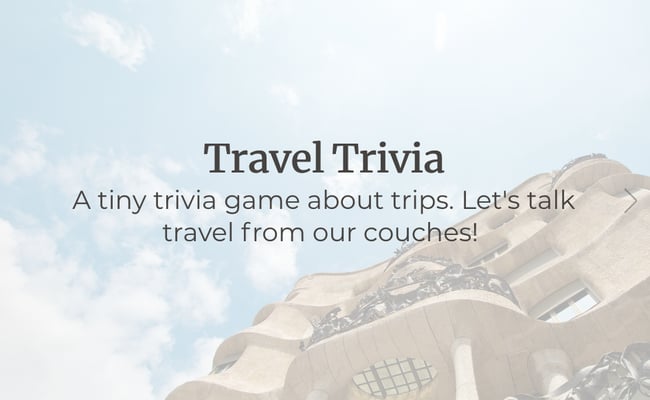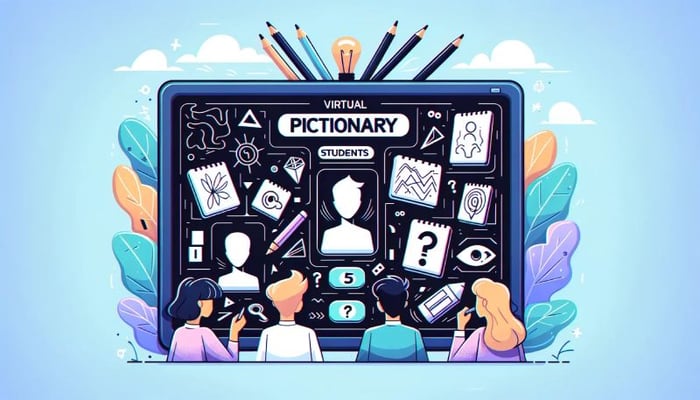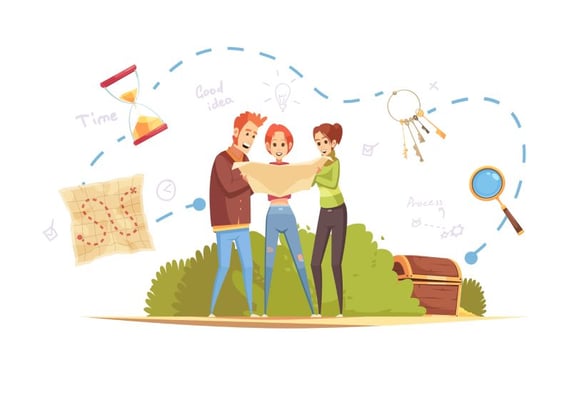
Discover the perfect solution for engaging groups and classrooms—online educational games. Transform lessons into lively, interactive experiences, making learning fun and inclusive. From math to history, these games enhance engagement and productivity, making them ideal for teachers and students alike. Explore our top 12 picks and revolutionize your classroom experience!
12 Best Online Group Games

"Good Morning Class" is an interactive icebreaker that sets the stage for an awesome, motivated classroom, where learning is a blast and everyone's engaged.
To play, create a presentation on "Slides with Friends," start the event, and have your students join via smartphone. Ask questions through the seven slides and foster discussions for communication. Conclude the game by summarizing responses and transitioning to the lesson.
“Good Morning Class” is suitable for all age groups. This fun game can seamlessly become a part of your learning journey, offering benefits like fostering camaraderie, as well as improving communication, engagement, and digital skills.
“First Letter, Last Letter” challenges players to showcase their vocabulary and quick-thinking skills. To play, you simply have a back-and-forth conversation — except there's one rule: each person must begin their next sentence or word with the letter the last person ended on. For example, if the first player says “I love apples”, the next must start their sentences with an s, like “Sure, but are they as good as oranges?.”
"First Letter, Last Letter" is typically suitable for students who are at least in elementary school or around 6-7 years old. It can be integrated into language lessons, making vocabulary, spelling, and word links a total hoot!

"Virtual Trivia" is a digital twist on the classic knowledge-testing game. Create a set of topic-specific trivia questions, form teams, and award points for correct answers. The age limit varies based on the game itself. There are cool trivia games made just for kids as young as 6 or 7.
You can also use “Slides with Friends” to create fun trivia quizzes. You get to choose from a number of exciting interactive templates that you can customize or enjoy right away. Want a quick game? Try out the “Travel Trivia” game which contains 12 slides and will take no more than 15 minutes. Or, if you're in for an epic trivia marathon, the Huge Movie Trivia game's got you covered with movie poster guessing and famous quotes to keep you entertained for more than an hour.
By incorporating trivia questions into their lessons, teachers can make sure that their students understand important concepts while keeping them engaged and excited. It's about working together and remembering cool facts, making the overall learning experience even more engaging.

“Virtual Pictionary” brings the classic drawing and guessing game into the digital realm! Most online Pictionary games recommend an age range of approximately 8 to 10 years and older.
To play, divide students into teams and choose words to draw. In each round, one team member becomes the illustrator, racing against the clock to depict the chosen word while teammates guess. No letters, numbers, or talking allowed!
“Virtual Pictionary” can become a creative classroom tool for teachers to enhance vocabulary and artistic talents with loads of fun. They can weave in educational themes and subject-related words, allowing students to brush up on their knowledge while having a blast drawing and guessing.
“Scattergories” is a word game where players must think of words that start with a specific letter and fit into given categories within a time limit. To play it online, gather your students, and when a round begins, you'll receive a category and a starting letter. Think up unique words that match both, and if no one else picks the same word, you score a point. Online “Scattergories” typically works best for players aged 12 and up.
Teachers and educators can use this fast-paced game to boost their students' vocabulary, critical thinking, and creativity. It's an interactive method to foster group dynamics, enhance communication, and refine problem-solving skills.
Online “Heads Up” is a great game for encouraging group interaction in the classroom. Players take turns guessing a word displayed on their foreheads, relying on their classmates' clues to figure it out. Typically, the online version of “Heads Up” is best suited for children around 8 years old or older.
Virtual “Heads Up” isn't just for fun; it can be a clever learning tool too! Teachers can tailor categories to match the curriculum, making lesson reviewing great fun. This game encourages teamwork, quick thinking, and communication skills, all while making learning an absolute blast!

Digital “Scavenger Hunt” is a great classroom game where the teacher curates a list of items and tasks that students must complete within a designated time frame. To make it educational, the items and activities can be connected to the lesson, adding a fun and engaging twist to learning. Typically, children around 8 years old and above can understand and enjoy the game.
Teachers can incorporate Digital “Scavenger Hunt” into lessons to reinforce concepts. By linking tasks to specific topics, it transforms the classroom into a lively arena of learning. Plus, it encourages collaboration and critical thinking, making learning feel like a thrilling treasure hunt!
“Geography Puzzles” puts your class's global knowledge to the test while fostering group interaction in a fun way. To play, send students a blank world map and challenge them to fill it out with as much accuracy as they can. You can use the Puzzle Masters Deck by Slides with Friends to create custom geography puzzles tailored to your students’ level of knowledge, adding an extra layer of excitement to the game. It's generally suitable for upper elementary students (around 10-11 years old) and older.
“Geography Puzzles” is a clever way to sprinkle some fun into your geography lessons. Teachers can tailor the challenge to match the class's skill level, making it a fantastic tool to learn and review countries, capitals, and more.
"Would You Rather" is a delightful icebreaker that encourages students to engage in lively discussions and share their preferences. To play, compile a list of thought-provoking prompts, and start the online lesson by asking students to choose between two intriguing options. Here is an example of an engaging "Would You Rather" question: “Would you rather have the intelligence of Hermione Granger from Harry Potter or the courage of Katniss Everdeen from The Hunger Games?”
"Would You Rather" is a versatile teaching tool. Teachers can customize prompts to link with lesson content, sparking discussions that reinforce classroom concepts. It promotes interaction, critical thinking, and retention of information while making learning an enjoyable adventure. The game is generally suitable for students around 10-11 years old and older.

"20 Questions" divides students into two groups, where one group thinks of an item, and the other group asks ten strategic yes-or-no questions to guess the object. Typically, “20 Questions” is appropriate for upper elementary students and older.
For example they might ask “Is it alive?” - yes. “Is it a person?” - yes. “Do I know them?” - yes. “Is it our teacher?” yes!
Teachers can tailor the game to any subject, sparking critical thinking and discussion. It promotes teamwork, effective communication, and problem-solving skills while making the classroom environment more interactive and enjoyable.
If your goal is to ignite creativity and a love for reading in your students, try playing "Complete a Story". It's all about giving your students a starting line or prompt, like "a boy running down the hill," and watching as students craft imaginative stories around it.
Typically, this game can be enjoyed by children in upper elementary grades, but it can be adapted for younger children with simpler prompts. To play "Complete a Story" online, you generally need access to a shared document or a more specialized online platform or app designed for collaborative storytelling.
In addition to boosting creativity and reading skills, "Complete a Story" fosters collaboration, sparks imaginative thinking, and helps students hone their comprehension skills, all while having a great time in the learning process.
"Sharp Memory" is a fun way to exercise your students’ memory muscles! You'll need to gather a few items like a pencil, mug, and chocolates, and then give your students a quick 20-second glimpse. Challenge them to list as many items as they can remember, and the student with the most items wins the game.
The game is typically suitable for children aged 6 and older. To play "Sharp Memory" online, you need a camera to display the chosen objects and a platform for sharing the video feed.
Teachers can use "Sharp Memory" to boost memory in a fun way. This engaging activity improves focus, quick thinking, and recall abilities, making learning a fun and interactive experience in the classroom.
